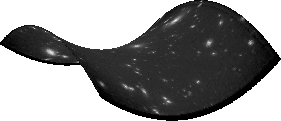35.4 The Geometry of the Universe
- General Relativity also predicts that the Universe must have
a distinct "shape", which depends directly on how much
mass is in it and on how fast it is expanding (i.e. the Hubble
Constant).
- The relevant parameter here is the critical density
of mass and energy, which, for H0 = 23 km/s/Mly, is
calculated to be
dc = 2.4 x 10-26 kg/m3
.
This is roughly fourteen hydrogen atoms per cubic meter, or
about one Milky Way-sized galaxy for every 4 Mly in each direction.
- Because of the cosmological principle, the actual density
of the Universe must be the same everywhere (at least over scales
larger than about 700 Mly).
There are therefore only three possibilities for the geometry
of the universe: flat, hyperbolic, and spherical.
 If the Universe has exactly
the critical density, it is said to be a critical or flat
Universe. If the Universe has exactly
the critical density, it is said to be a critical or flat
Universe.
Imagine that instead of being three dimensional, the Universe
was two-dimensional.
Imagine also that you could stand "outside" of it and
look at it (although in actuality this is not possible -- everything
is inside the Universe!).
A flat Universe would then appear to be a plane (it would have
zero curvature).
 From within a flat Universe, we
could determine its geometry by the fact that two parallel beams
of light will always remain parallel to each other. From within a flat Universe, we
could determine its geometry by the fact that two parallel beams
of light will always remain parallel to each other.
A flat Universe must have no edges and therefore
must extend indefinitely in every direction (or else it would
violate the cosmological principle).
- One way for a flat Universe to extend indefinitely is if
the Universe is infinite in size.
Such a Universe is also said to be open.
In an open Universe, a light beam will never return to its starting
point.
- Another way for a flat Universe to extend indefinitely is
if the Universe connects back on itself after a certain distance,
in which case it is finite in size.
Such a Universe is also said to be closed.
In the picture below, you can see how a finite Universe appears
to repeat itself over and over again (but it is actually only
the size of the colored square).
In each picture, the red edge connects to the red edge and the yellow edge connect to the yellow edge, etc.
In the left-hand picture the connection is direct, while in the right-hand picture the connection is to the opposite end, making the space "twisted" (like a Möbius
strip).
With a three-dimensional space, there are even more ways for
a closed Universe to be connected together.
In a closed Universe, a light beam will eventually return to
its starting point, and then retraverse the same distance, over
and over again.
Question: For these two Universes,
how do they differ with respect to the distance travelled by
a light beam before it returns to its starting point?
- If the Universe is closed, we should be able to "see
ourselves" by looking far enough away in the distance.
The only problem is that we are also looking back in time, since
light takes a finite time to traverse the Universe and return
to us.
This distorts our view since we would be seeing our galaxy when
it was much younger, and we might not recognize it!
 If the Universe has less
than the critical density, gravity is relatively weak, and the
expansion causes space to curve away from itself. If the Universe has less
than the critical density, gravity is relatively weak, and the
expansion causes space to curve away from itself.
The Universe is then said to be hyperbolic.
To an imaginary outside observer, a hyperbolic Universe would
appear to have a saddle shape (it would have negative curvature).
 Within a hyperbolic Universe,
two parallel beams of light will diverge from each other. Within a hyperbolic Universe,
two parallel beams of light will diverge from each other.
A hyperbolic Universe, like a flat universe, must extend indefinitely
far in every direction, and again could be either open or closed.
 If the Universe has more
than the critical density, gravity is relatively strong, and
causes space to fold over towards itself. If the Universe has more
than the critical density, gravity is relatively strong, and
causes space to fold over towards itself.
The Universe is then said to be spherical.
To an imaginary outside observer, a spherical Universe would
appear like the surface of a sphere (it would have positive
curvature).
Note that the spherical Universe does not include the interior
of the sphere (and therefore has no center, in compliance with
the cosmological principle).
 Within a spherical Universe, two
parallel beams of light will converge together and cross each
other. Within a spherical Universe, two
parallel beams of light will converge together and cross each
other.
Unlike a flat or hyperbolic Universe, the spherical Universe
is necessarily finite in size and closed.
The spherical Universe still extends indefinitely, just like
here on the surface of the Earth, where you can circle the globe
forever if you chose to do so.
|